Class 10th Science - Life Processes Case Study Questions and Answers 2022 - 2023
By QB365 on 09 Sep, 2022
QB365 provides a detailed and simple solution for every Possible Case Study Questions in Class 10 Science Subject - Life Processes, CBSE. It will help Students to get more practice questions, Students can Practice these question papers in addition to score best marks.
QB365 - Question Bank Software
Life Processes Case Study Questions With Answer Key
10th Standard CBSE
-
Reg.No. :
Science
-
The small intestine is the longest part of the alimentary canal. It is a narrow tube of about 6 metres which lies coiled in the abdomen. The length of small intestine varies in different animals depending on the type of food they eat.
(i) Humans are not able to digest cellulose whereas they are able to digest starch due to(a) absence of enzyme cellulase (b) alkaline pH in small intestine (c) presence of villi (d) acidic pH in stomach (ii) What will happen if the lining X shown in the figure of transverse section of gut is smooth instead of having such foldings?
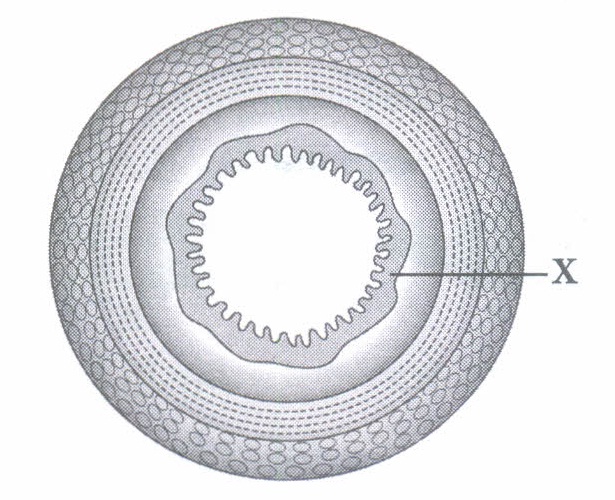
(a) Surface area of absorption will be enhanced (b) Surface area of absorption will be reduced (c) Alkaline pH will be changed into acidic pH (d) None of these (iii) Butter cannot be digested in the stomach as lipase and bile are(a) released in small intestine
(a) released in small intestine (b) inactive in stomach (c) released in large intestine (d) absorbed in the stomach. (iv) Which of the following is a correct statement?
(a) Herbivores have shorter small intestine as they eat grasses
(b) Carnivores have larger small intestine as they eat meat
(c) Herbivores have larger small intestine as they eat grasses
(d) None of these
(v) Various types of movements are generated by the ______ layer of the small intestine.(a) serosa (b) muscularis (c) mucosa (d) submucosa (a) -
Water is very important chemical, required as solvent, in many biological processes. It is needed as raw material in photosynthesis, as a main substance from which plants evolve oxygen and provide hydrogen for the synthesis of carbohydrates. It helps in translocation of chemical substances and minerals and in this manner maintains internal transportation. Osmosis is a special type of transport of water molecules that occurs through semipermeable membrane. Osmosis is movement of solvent from the region of higher diffusion pressure to the lower diffusion pressure across a semipermeable membrane. It is of two types - endosmosis and exosmosis. Endosmosis is the osmotic entry of water into a cell, organ or system. Exosmosis is the osmotic withdrawal of water from a cell, organ or system.
(i) A flowering plant is planted in an earthen pot and irrigated. Urea is added in high amounts to make the plant grow faster, but after sometime the plant died. This may be due to(a) exosmosis (b) endosmosis (c) water logging (d) suffocation (ii) A slice of sugar beet placed in concentrated salt solution would
(a) show no change
(b) loose water and become flaccid initially
(c) absorb small quantity of water
(d) become swollen
(iii) The process of diffusion is involved in(a) respiration (b) photosynthesis (c) transpiration (d) all of these. (iv) The plant cell cytoplasm is surrounded by both cell wall and cell membrane. The specificity of transport of substances is mostly across the cell membrane, because
(a) cell membrane is impermeable
(b) cell membrane is selectively permeable
(c) cell membrane is fully permeable
(d) cell wall is impermeable.
(v) Based on the given figure which of the following statements is incorrect?
(a) Movement of solvent molecules will take place from chamber A to B.
(b) Movement of solute will take place from A to B.
(c) Presence of a semi-permeable membrane is a prerequisite for this process to occur.
(d) The direction and rate of osmosis depends on both the pressure gradient and concentration gradient(a) -
Given are the sections of two pipes, A and B. If you need to represent blood vessels with these, which of the pipes would correspond to the artery and which one to a vein. Identify it and answer the following questions.
(i) B is best defined as the vessel which
(a) always supply oxygenated blood to the different organs
(b) always carry blood away from the heart to different organs
(c) always break up into capillaries that reunite to form a vein
(d) always carry blood from one visceral organ to another visceral organ.
(ii) In A, valves are present to check backward flow of blood flowing at(a) atmospheric pressure (c) low pressure (b) high pressure (d) all of these (iii) Which of the following statements is correct regarding A?
(a) Carries blood from an organ towards the heart
(b) Always carry oxygenated blood with single exception
(c) Carries blood from heart towards the organ
(d) All of these
(iv) Which of the following statements is incorrect?
(a) A has typically larger lumen than B.
(b) Walls of B are elastic enabling them to stretch and shrink during changes in blood pressure
(c) Flow of blood is slower in A than in B
(d) None of these
(v) Blood pressure in the pulmonary artery is(a) more than that of pulmonary vein (b) less than that in the vena cava (c) same as that in aorta (d) less than pulmonary vein. (a) -
Our body needs to remove the wastes that build up from cell activities and from digestion. It these wastes are not removed, then our cells can stop working and we can get very sick. The organs of our excretory system help to release wastes from our body. The excretory system consists of a pair of kidney, a pair of ureters, a urinary bladder and a urethra. Each kidney is made up of nearly one million complex tubular structures called nephrons. The formation of urine involves various processes that takes place in the different parts of the nephron. Each nephron consists of a cup-shaped upper end called Bowman's capsule containing a bunch of capillaries called glomerulus. Bowman's capsule leads to tubular structure-proximal convoluted tubule, loop of Henle and distal convoluted tubule which ultimately joins the collecting tubule.
(i) The following substances are the excretory products in animals. Choose the least toxic form.(a) Urea (b) Uric acid (c) Ammonia (d) CO2 (ii) The outline of principal events of urination is given below in random manner.
(I) Stretch receptors on the wall of urinary bladder send signals to the CNS.
(II) The bladder fills with urine and becomes distended.
(III) Micturition
(IV) CNS passes on motor messages to initiate the contraction of smooth muscles of bladder and simultaneous relaxation of urethral sphincter.
The correct sequence of the events is(a) (I) \(\rightarrow\)(II) \(\rightarrow\) (III) \(\rightarrow\) (IV) (c) (II) \(\rightarrow\)(I) \(\rightarrow\) (IV) \(\rightarrow\) (III) (b) (IV)\(\rightarrow\) (III) \(\rightarrow\) (II) \(\rightarrow\) (I) (d) (III) \(\rightarrow\) (II)\(\rightarrow\) (I) \(\rightarrow\) (IV) (iii) A person who is not taking food or beverages will have ___________ in urine.
(a) little glucose (b) less urea (c) excess urea (d) little fat (iv) Glomerular filtrate is first collected by
(a) distal convoluted tubule (b) proximal convoluted tubule (c) Bowman's capsule (d) loop of Henle (v) The given figure represents a single nephron from a mammalian kidney. Identify the labelled parts, match them with the options (i-iv) and select the correct answer.
(I) The site of ultrafiltration
(II) Collect the urine and make it more concentrated
(III) The main site for the reabsorption of glucose and amino acids
(IV) Largely responsible for the maintenance of blood pH(a) (I)-A, (II)-E, (lII)-C, (IV)-D (b) (I)-A, (lI)-B, (lII)-C, (lV)-D (c) (I)-B, (II)-A, (lII)-C, (IV)-E (d) (I)-E, (lI)-B, (lII)-D, (lV)-A (a) -
All living cells need nutrients,O2 and other essential substances. Also, the waste and harmful substances need to be removed continuously for healthy functioning of cells. So, a well developed transport system is mandatory for living organisms. Complex organisms have special fluids within their bodies to transport such materials. Blood is the most commonly used body fluid by most of the higher organisms. Lymph also helps in the transport of certain substances.
(i) Which of the following does not exhibit phagocytic activity?(a) Monocytes (b) Neutrophils (c) Basophil (d) Macrophage (ii) Amount of blood corpusles in changed in dengue fever. One of the common symptoms observed in people infected with dengue fever is
(a) Significant decrease in RBC count (b) Significant decrease in WBC count (c) significant decrease in platelets count (d) significant increase in platelets count. (iii) Why are WBCs called soldiers of the body?
(a) They are capable of squeezing out of blood capillaries.
(b) They are manufactured in bone marrow.
(c) They fight against disease causing germs.
(d) They have granular cytoplasm with lobed nucleus.
(iv) Name the blood cells, whose reduction in number can cause clotting disorder, leading to excessive loss of blood from the body(a) Erythrocytes (b) Neutrophils (c) Leucocytes (d) Thrombocytes (v) Which of the following is the correct feature oflymph?
(a) It is similar to the plasma of blood, but is colourless and contains less proteins.
(b) It is similar to the WBCs of blood, but is colourless and contain more proteins.
(c) It is similar to the RBCs of blood and red in colour.
(d) It contains more fats(a) -
In fermentation, the incomplete oxidation of glucose achieved under anaerobic conditions by sets of reactions where pyruvic acid is converted to CO2 and ethanol. The enzymes, pyruvic acid decarboxylase and alcohol dehydrogenase catalyse these reactions.
(i) The given experimental set-up demonstrates

(a) photosynthesis (b) aerobic respiration (c) anaerobic respiration (d) ascent of sap (ii) Fermentation is represented by the equation
\(\text { (a) } \mathrm{C}_{6} \mathrm{H}_{12} \mathrm{O}_{6}+6 \mathrm{O}_{2} \rightarrow 6 \mathrm{CO}_{2}+6 \mathrm{H}_{2} \mathrm{O}+686 \mathrm{kcal}\)
\(\text { (b) } \mathrm{C}_{6} \mathrm{H}_{12} \mathrm{O}_{6} \rightarrow 2 \mathrm{C}_{2} \mathrm{H}_{5} \mathrm{OH}+2 \mathrm{CO}_{2}+59 \mathrm{kcal}\)
\(\text { (c) } 6 \mathrm{CO}_{2}+12 \mathrm{H}_{2} \mathrm{O} \frac{\text { Light }}{\text { Chlorophyll }}>\mathrm{C}_{6} \mathrm{H}_{12} \mathrm{O}_{6}+6 \mathrm{H}_{2} \mathrm{O}+6 \mathrm{O}_{2}\)
\(\text { (d) } 6 \mathrm{CO}_{2}+6 \mathrm{H}_{2} \mathrm{O} \rightarrow \mathrm{C}_{6} \mathrm{H}_{12} \mathrm{O}_{6}+6 \mathrm{O}_{2} \text { . }\)
(iii) A test tube containing molasses solution and yeast is kept in a warm place overnight. The gas collected from this mixture(a) extinguishes the flame (b) bursts into flame when ignited (c) turns lime water milky (d) both (a) and (c) (iv) Ethyl alcohol fermentation occurs in
(a) Lactobacillus (b) muscles of humans (c) Yeast (d) all of these (v) Though vertebrates are aerobes, but their (i) show anaerobic respiration during (ii) During this (iii) of skeletal muscle fibres is broken down-to release lactic acid and energy. Lactic acid, if accumulates causes muscle fatigue.
Fill up the blanks in the above paragraph and select the correct option(i) (ii) (iii) (a) skeletal muscles heavy exercise glucose (d) skeletal muscles mild exercise glycogen (c) skeletal muscles heavy exercise glycogen (d) cardiac muscles heavy exercise glycogen (a) -
Double circulation is a type of circulating system in which the blood passes through the heart twice before completing a full circuit of the body. Blood is pumped from the heart to the lungs and returns to the heart before being distributed to other organs and tissues of the body.
(i) The figure shows blood circulation in humans with labels A to D. Select the option which gives correct identification of label and functions of the part.
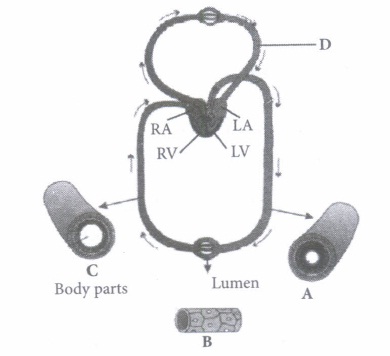
(a) B - Capillary- Thin without muscle layer and wall two cell layers thick
(b) C - Vein-Thin walled and blood flows in jerks/spurts
(c) D - Pulmonary vein-Takes oxygenated blood to heart, PO2 = 95 mm Hg
(d) A - Artery-Thick walled and blood flows evenly
(ii) Incomplete double circulation is seen in(a) mammals (b) pisces (c) aves (d) amphibians. (iii) Which of the following animals shows double circulatory pathway?
(a) Snake (b) Frog (c) Eel (d) Whale (iv) The given figure is of circulatory system. Identify the labelled parts (A-D) from the list (I-VII).
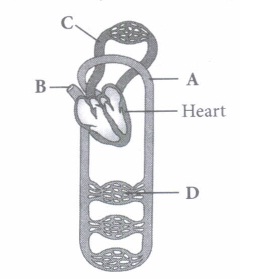
(I) Pulmonary circulation (II) Systemic circulation (III) Superior vena cava (IV) Inferior vena cava
(V) Aorta (VI) Veins and venules (VII)Arterioles and capillaries(a) A-(V), B-(lII), C-(I), D-(VII) (b) A-(VII), B-(IV), C-(I), D-(VI) (c) A-(V), B-(III), C-(lI), D-(VII) (d) A-(VII), B-(V), C- (I), D-(VI) (v) Select the option which properly represents pulmonary circulation in humans.
\(\text { (a) Left auricle } \frac{\text { Deoxygenated }}{\text { blood }}{\longrightarrow} \text { Lungs } \frac{\text { Oxygenated }}{\text { blood }} \text { Right ventricle }\)
\(\text { (b) Left auricle } \frac{\text { Oxygenated }}{\text { blood }}{\longrightarrow} \text { Lungs } \frac{\text { Deoxygenated }}{\text { blood }}{\longrightarrow} \text { Right ventricle }\)
\(\text { (c) Right ventricle } \frac{\text { Deoxygenated }}{\text { blood }}{\longrightarrow} \text { Lungs } \frac{\text { Oxygenated }}{\text { blood }} \rightarrow \text { Left auricle }\)
\(\text { (d) Right ventricle } \frac{\text { Oxygenated }}{\text { blood }}>\text { Lungs } \frac{\text { Deoxygenated }}{\text { blood }} \gg \text { Left auricle }\)(a) -
Transpiration is the evaporative loss of water by plants. It occurs mainly through the stoma in the leaves. Besides the loss of water vapour in transpiration, exchange of oxygen and carbon dioxide in the leaf also occurs through pores called stomata. Normally stomata remain open in the day time and close during the night
(i) Which of the following will not directly affect transpiration?(a) Temperature (b) Light (c) Wind speed (d) Chlorophyll content of leaves (ii) Water vapour comes out from the plant leaf through the stomatal opening. Through the same stomatal opening, carbon dioxide diffuses into the plant during photosynthesis. Reason out the above statements . using one of following options.
(a) The above processes happen only during night time.
(b) One process occurs during day time and the other at night.
(c) Both processes cannot happen Simultaneously.
(d) Both processes can happen together at day time.
(iii) Which of the following statements is not true for stomatal apparatus?
(a) Guard cells invariably possess chloroplasts and mitochondria.
(b) Guard cells are always surrounded by subsidiary cells.
(c) Stomata are involved in gaseous exchange.
(d) Inner wall of guard cells are thick.
(iv) Which of the following is not a purpose of transpiration?
(a) Helps in absorption and transport in plants
(b) Prevents loss of water
(c) Maintains shape and structure of plants by keeping the cells turgid
(d) Supplies water for photosynthesis
(v) Refer to the given graphs regarding factors affecting transpiration rate and select the correct option.
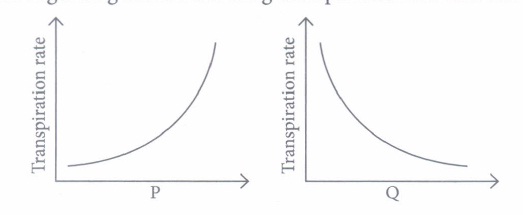
(a) P-Atmospheric temperature; Q-Atmospheric pressure
(b) P-Relative humidity; Q-Atmospheric temperature
(c) P-Air movement; Q-Light
(d) P-Atmospheric pressure; Q-Relative humidity(a) -
We need energy to perform various activities. This energy is derived from the catabolism of various components of food, e.g., proteins, carbohydrates, fats, etc. Oxygen is required for catabolic processes and carbon dioxide is released in the process. So, the body requires a continuous exchange of gases, oxygen from the atmosphere is taken inside and carbon dioxide produced is given out. In human beings, respiratory pigment called haemoglobin present in RBCs has very high affinity for oxygen. In tissues, exchange of gases occurs between oxygenated blood and tissue cells.
(i) People living at sea level have around 5 million RBCs per cubic millimetre of their blood whereas those living at an altitude of 5400 metres have around 8 million. This is because at high altitude
(a) people eat more nutritive food, therefore more RBCs are formed
(b) people get pollution-free air to breathe and more oxygen is available
(c) atmospheric 02 levelisless and hence more RBCs are needed to absorb the required amount of 02 to survive
(d) there is more UV radiation which enhances RBC production.
(ii) The given graph illustrates the changes in lung volume during the process of breathing .
The change from II to III indicates the(a) movement of diaphragm away from the lungs (b) expansion of the thoracic cavity (c) movement of air out of the lungs (d) expansion of ribs. (iii) Which one of the following is a possibility for most of us in regard to breathing, by making a conscious effort?
(a) One can breathe out air totally without oxygen.
(b) One can breathe out air through Eustachian tube by closing both nose and mouth.
(c) One can consciously breathe in and breathe out by moving the diaphragm alone, without moving the ribs at all.
(d) The lungs can be made fully empty by forcefully breathing out all air from them.
(iv) Refer to the given figure and answer the following question .
Which of these parts
(I) are the actual sites of respiratory gas exchange?
(II) is the common passage for air and food?
(III) is provided with incomplete cartilaginous rings?
(IV) relaxes and gets back to its original shape during expiration?
(v) moves upwards and outwards during inspiration?(a) (I) - s, (II) - p, (III) - q, (IV) - r, (V) - t
(c) (I) - t, (II) - q, (III) - r, (IV) - s, (V) - P (b) (I) - r, (II) - p, (III) - q, (IV) - s, (V) - t (d) (I) - p, (II) - q, (III) - r, (IV) - s, (V) - t (v) Which of the following sequences is correct to initiate inspiration?
(I) The contraction of intercostal muscles raises the ribs and sternum
(II) Volume of thorax increases
(III) Intrathoracic pressure of the lungs decreases
(IV) Diaphragm contraction
(v) Air rushes into lungs(a) (I), (II), (IV), (V), (III) (b) (I), (II), (III), (IV), (V) (c) (I), (IV), (II), (III), (V) (d) (V), (I), (II), (III), (IV) (a) -
The green plants make their food, through photosynthesis and are therefore called autotrophs. All other organisms depend upon green plants for food and are referred to as heterotrophs. Green plants carry out photosynthesis by using light energy of sun. The first phase of reactions are directly light driven therefore called light reactions. The second phase of reactions are not directly light driven but are dependent on the products of light reactions and are called dark reactions.
(i) Which of the following is produced during the light phase of photosynthesis?(a) ATP (b) NADPH (c) Carbohydrate (d) Both (a) and (b) (ii) In the overall process of photosynthesis, the number of sugar molecules produced is
(a) 12 (b) 6 (c) 4 (d) l (iii) A plant is provided with ideal conditions for photosynthesis and supplied with isotope 14CO2. When the products of the process are analysed carefully, what would be the nature of products?
(a) Both glucose and oxygen are normal.
(b) Both glucose and oxygen are labelled.
(c) Only glucose is labelled and oxygen is normal.
(d) Only oxygen is labelled and glucose is normal.
(iv) Refer to the given diagrammatic representation of an electron micrograph of a section of chloroplast and answer the question .
Select the option which correctly depicts the functions of parts X, Y and Z.X Y Z (a) Dark reaction Light reaction Carbohydrate synthesis (b) Light reaction Carbohydrate synthesis Carbohydrate storage (c) Light reaction Carbohydrate storage Carbohydrate synthesis (d) Carbohydrate synthesis Carbohydrate storage Cytoplasmic inheritance (v) Following table summarises the differences between light and dark reactions.
Light reactions Dark reactions (I) These are also called biosynthetic phase These are also called photochemical phase. (II) These reactions occur over thylakoids. These reactions occur in stroma of chloroplasts (III) These produce assimilatory power i.e NADPH and ATP These consume NADPH and ATP (IV) These are directly dependent upon light They depend upon the products synthesised during light reactions Which of the following is correct group of differences?
(a) (I), (II) and (III) (b) (II), (III) and (IV) (c) (II) and (III) (d) (I) and (IV) (a) -
Digestion is a catabolic process in which complex and large components of food are broken down into their respective simpler and smaller forms with the help of various hydrolytic enzymes. In human, the process of intake of essential nutrients in the form of food takes place through an entire system known as digestive system. The digestive system in human includes alimentary canal and its associated digestive glands.
(i) Identify the cells whose secretion protects the lining of gastro-intestinal tract from various enzymes.(a) Duodenal cells (b) Chief cells (c) Goblet cells (d) Oxyntic cells (ii) Digestion of proteins is incomplete in the absence of enterokinase, because
(a) trypsinogen is not converted into trypsin
(b) pepsinogen is not converted into pepsin
(c) prorennin is not converted into rennin
(d) chymotrypsinogen is not converted into chymotrypsin
(iii) Match the column I with column II and column III. Choose the correct option.Column I Column II Column III (Substrate) (Enzyme) (Product) 1. Lactose A. Lipase I. Galactose 2. Fatty acid B. Trypsin II. Maltose 3. Starch C. Lactase III. Glycerol 4. Proteins D. Amylase IV. Dipeptides (a) 1- A-I; 2-C-II; 3-B-III; 4-D-IV (b) I-D-I; 2-A-II; 3-B-III; 4-C-IV (c) l-C-I; 2-A-III; 3-D-II; 4-B-IV (d) l-C-I; 2-A-II; 3-D-III; 4-B-IV (iv) A and B in the given graph are the action spectra of the two enzymes. The two enzymes are
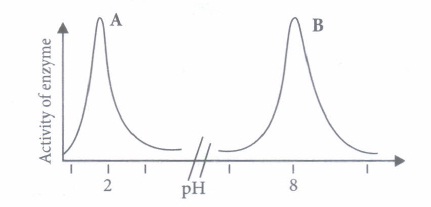
(a) A: amylase B: trypsin (b) A: pepsin B: trypsin (c) A: chymotrypsin B: rennin (d) A: lactate dehydrogenase B: amylase. (v) If the inner surface of the ileum in the human small intestine was smooth, rather than being folded and subdivided into villi, which of the following statements would be true?
(a) The rate of absorption of digested food molecules would be higher, because the digested food would pass more easily through the digestive tract.
(b) Digestion would not be as effective, because there would be fewer cells secreting trypsin (a proteindigesting enzyme).
(c) Humans would have needed to evolve a much longer small intestine to absorb sufficient nutrients from their food.
(d) Humans would not be able to survive, because the digestive tract would be more susceptible to damage.(a) -
Respiration is an energy releasing enzymatically controlled process which involves a stepwise oxidative breakdown of food substances inside living cells. The oxidative breakdown of respiratory substrates with the help of atmospheric oxygen is aerobic respiration. Glucose is completely broken down into CO2 and H2O by this process of oxidation and large amount of energy is produced.
(i) Site of Krebs' cycle is(a) peroxisome (b) cytoplasm (c) mitochondria (d) none of these. (ii) The pathway of respiration common in all living organisms is X ;it occurs in the Y and the products formed are two molecules of Z.
Identify X, Y and Z in the above paragraph and select the correct answer.X Y Z (a) glycolysis mitochondrion pyruvic acid (b) glycolysis cytoplasm pyruvic acid (c) Krebs' cycle cytoplasm acetyl CoA (d) Krebs' cycle mitochondrion acetyl CoA (iii) Number of oxygen molecules utilised in glycolysis is ____________.
(a) 0 (b) 2 (c) 4 (d) 6 (iv) How many ATP molecules could maximally be generated from one molecule of glucose, if the complete oxidation of one molecule of glucose to CO2 and H2O yields 686 kcal and the useful chemical energy available in the high energy phosphate bond of one molecule of ATP is 12 kcal?
(a) 1 (b) 2 (c) 30 (d) 57 (v) The end product of aerobic respiration is
(a) NADH (b) oxygen (c) ADP (d) CO2 + ATP + H2O (a) -
Heterotrophic nutrition is a mode of nutrition in which organisms obtain readymade organic food from outside sources. The organisms that depend upon outside sources for obtaining organic nutrients are called heterotrophs. Heterotrophic nutrition is of three types: saprophytic, parasitic and holozoic nutrition.
(i) In which of the following groups of organisms food material is broken outside the body and absorbed?(a) Mushroom, green plants, Amoeba (b) Yeast, mushroom, bread mould (c) Paramecium, Amoeba, Cuscuta (d) Cuscuta, lice, tapeworm (ii) Which of the following is a parasite?
(a) Yeast (b) Taenia (c) Amoeba (d) Earthworm (iii) Which of the following is an example of saprotroph?
(a) Grass (b) Mushroom (c) Amoeba (d) Paramecium (iv) Heterotrophic nutrition involves
(a) production of simple sugar from inorganic compounds
(b) utilisation of chemical energy to prepare food
(c) utilisation of energy obtained by plants
(d) all of these.(v) In Paramecium, food enters the body through
(a) mouth (b) pseudopodia (c) cilia (d) cytostome (a) -
The small intestine is a tubular structure within the abdominal cavity that carries the food in continuation with the stomach up to the colon from where the large intestine carries it to the rectum and out of the body. The main function of this organ is to aid in digestion. All nutrients are usually absorbed into blood across the mucosa of the small intestine. In addition, the small intestine absorbs water and electrolytes, thus playing critical role in maintenance of body water and acid-base balance.
(i) Which of the following is incorrect regarding intestinal villi?
(a) They possess microvilli.
(b) They increase the surface area.
(c) They are supplied with capillaries and the lacteal vessels.
(d) They only participate in digestion of fats
(ii) Which enzymes are likely to act on the baked potatoes eaten by a man, starting from the mouth as they move down the alimentary canal?
(a) Pancreatic amylase \(\rightarrow\) Salivary amylase \(\rightarrow\) Lipases
(b) Disaccharidase like maltase \(\rightarrow\) Lipases \(\rightarrow\) Nucleases
(c) Salivary amylase \(\rightarrow\) Pancreatic amylase \(\rightarrow\) Disaccharidases
(d) Salivary maltase \(\rightarrow\) Carboxypeptidase \(\rightarrow\) Trypsinogen
(iii) After surgical removal of an infected gall bladder, a person must be especially careful to restrict dietary intake of
(a) starch (b) protein (c) sugar (d) fat.
(iv) The given flow chart shows the fate of carbohydrates during digestion in the human alimentary canal. Identify the enzymes acting at stages indicated as A, B, C and D and select the correct option.
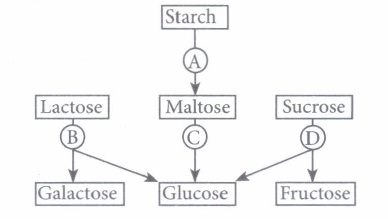
(a) A - Amylase, B - Maltase, C - Lactase, D - Invertase
(b) A - Amylase, B - Maltase, C - Invertase, D - Lactase
(c) A - Amylase, B - Invertase, C - Maltase, D - Lactase
(d) A - Amylase, B - Lactase, C - Maltase, D - Invertase
(v) The given diagram represents a section of small intestinal mucosa. Identify A, Band C.(a) A-Villi, B-Lacteal, C-Capillaries (b) A-Lacteal, B-Villi, C-Capillaries (c) A-Villi, B-Lacteal, C-Crypts (d) A-Crypts, B-Lacteal, C-Capillaries (a) -
The food which is prepared by the process of photosynthesis in the leaves of a plant has to be transported to other parts like stem, roots, branches, etc. Therefore this food is transported to other parts of the plant through phloem.
(i) A few drops of sap were collected by cutting across a plant stem by a suitable method. The sap was tested chemically. Which one of the following test results indicates that it is phloem sap?(a) Acidic (b) Alkaline (c) Low refractive index (d) Absence of sugar (ii) What is the direction of movement of sugars in phloem?
(a) Bi-directional (b) Non-directional (c) Upward (d) Downward (iii) The given diagram shows a potato plant forming new tubers. Which route would be taken by most of the food at this time?
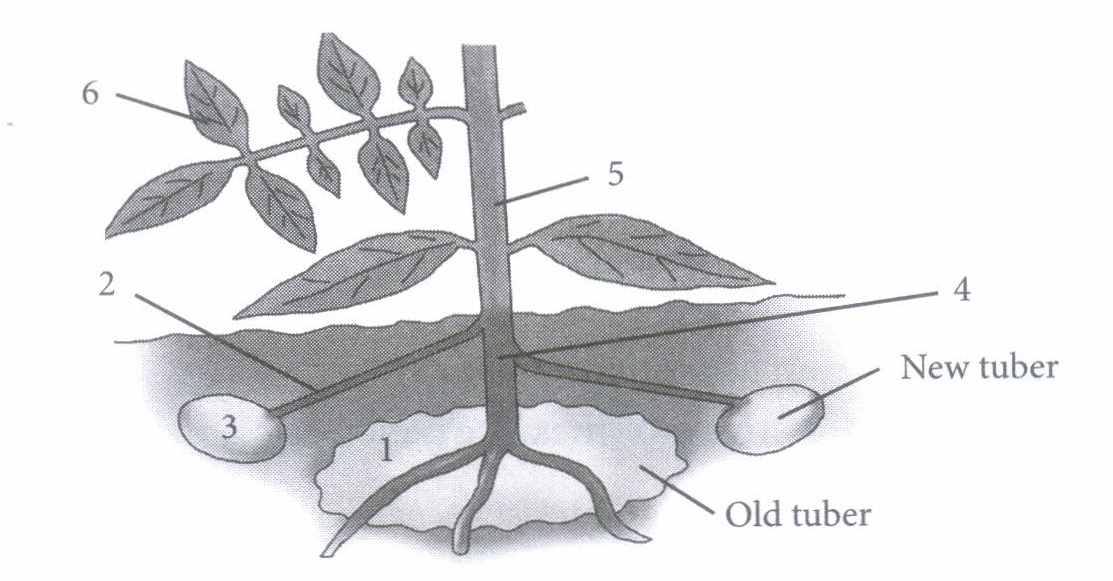
\(\text { (a) } 1 \rightarrow 4 \rightarrow 2 \rightarrow 3\) \(\text { (b) } 6 \rightarrow 5 \rightarrow 2 \rightarrow 3\) \(\text { (c) } 1 \rightarrow 4 \rightarrow 5 \rightarrow 6\) \(\text { (d) } 6 \rightarrow 5 \rightarrow 4 \rightarrow 1\) (iv) A girdled plant (upto bast) may survive for some time but it will eventually die, because
(a) water will not move downwards
(b) water will not move upwards
(c) sugars and other organic materials will not move downwards
(d) sugars and other organic materials will not move upwards
(v) Phloem sap is mainly made of(a) water and sucrose (b) water and minerals (c) oligosaccharides and hormones (d) sucrose only (a)
Case Study
*****************************************
Answers
Life Processes Case Study Questions With Answer Key Answer Keys
-
(i) (a): In human, cellulose is indigestible as it cannot be broken into smaller molecules due to absence of cellulase enzyme.
(ii) (b): Finger-like projections that come out from mucosa of intestine form villi. Cells lining the villi produce numerous microscopic projections called microvilli giving a brush border appearance which increase the surface area for absorption enormously. Villi has a good supply of capillaries and a large lymph vessel for absorption of nutrients. If the inner lining of the small intestine will be smooth, the surface for absorption will be reduced.
(iii) (a)
(iv) (c)
(v) (b) -
(i) (a): Urea solution is more concentrated than the sap present in plant cells, so plant cells lose water to the soil through the process of exosmosis. Loss of water caused plant to die.
(ii) (b)
(iii) (d): Diffusion keeps the cell walls of the internal plant tissues moist. It is a means of spreading of ions and other substances through protoplast. Transpiration or loss of water in vapour form is a diffusion process. Exchange of gases during photosynthesis and respiration between the plant interior and outside air also occurs through diffusion.
(iv) (b)
(v) (b) -
(i) (b): In the given figures B represents artery that carry blood away from the heart to different organs.
(ii) (c): In the given figures, A represents vein. Veins bring blood from different body parts to the heart. The flow of blood in veins is not so fast because the blood in veins is under low pressure. Veins possess valves which prevent backward flow of blood.
(iii) (a): Veins carry deoxygenated blood with single exception, i.e., pulmonary vein. Arteries carry blood from heart towards the organ.
(iv) (d)
(v) (a) -
(i) (b):Nitrogenous waste substances such as ammonia, urea or uric acid are produced during protein metabolism. Ammonia is the most toxic, followed by urea and uric acid. Uric acid is least toxic.
(ii) (c)
(iii) (b): Urea is a nitrogenous waste formed as a result of metabolism of various food/beverages in the body and is excreted in the urine. So,if a person is not taking food/beverages he will have less urea in his urine.
(iv) (c)
(v) (a): Malpighian corpuscle (A) is the site of ultrafiltration. A considerable amount of water is reabsorbed in the collecting duct (E) under the influence of ADH. Proximal convoluted tubule (C) is the main site for the reabsorption of glucose and amino acids. In distal convoluted tubule (D), bothhydrogen ions and ammonium ions are secreted, thus it maintains blood pH. -
(i) (c): Basophiles release heparin, serotonin and histamine. They are like mast cells of connective tissue and are not phagocytic in nature.
(ii) (c)
(iii) (c) : WBCs manufacture antibodies, which fight against disease causing germs and are responsible for immunity, thus called soldiers of the body.
(iv) (d)
(v) (a): Lymph is a colourless fluid, which contains blood plasma along with leucocytes and have fewer proteins. -
(i) (c): In the test tube full of mercury (figure A) there is no air and, therefore, the introduced soaked seeds do not get air for aerobic respiration. But they are capable of respiration in the absence of oxygen as is indicated by the evolution of carbon dioxide (figure B). Therefore, anaerobic respiration takes place in the seeds in the absence of free oxygen. The experiment also shows that CO2 is evolved in anaerobic respiration of seeds.
(ii) (b)
(iii) (d): The given process is an example of alcoholic fermentation, thus the gas produced is CO2 .
(iv) (c): Ethyl alcohol fermentation occurs in fungi such as Rhizopus, yeast and bacteria.
(v) (a): Muscle fatigue is the reduction in force of contraction of a muscle after prolonged stimulation. In the absence of oxygen, skeletal muscle of human beings can contract for a short time, but it gets fatigued soon. This is due to the fact that in the absence of oxygen, products of glycolysis mainly lactic acid is not disposed off and accumulates in the muscles. This leads to muscle fatigue and pain in the muscles. A muscle gets fatigued sooner after a strenuous exercise than after a mild exercise. Faster breathing for sometime after a strenuous exercise supplies extra oxygen, disposes off excess lactic acid and muscle fatigue disappears. -
(i) (c): A- Artery: Carries blood from heart to different body parts. It is thick-walled and elastic. It acts as a "pressure reservoir" for maintaining the blood flow. B - Capillary : Nutrients, hormones, gases, etc. can diffuse into tissue cells through capillaries and vice versa. It is thin-walled, and only one cell layer thick resting on basement membrane. C - Vein: Brings blood from different body parts to the heart. It is thin-walled and act as low-resistance conduct for blood flow. D - Pulmonary vein: Two pulmonary veins from each lung transport the oxygenated blood to the left atrium.
(ii) (d): In amphibians, the left atrium receives oxygenated blood from the gills/lungs/skin and the right atrium gets the deoxygenated blood from other body parts. However, they get mixed up in the single ventricle which pumps out mixed blood i.e., incomplete double circulation
(iii) (d): Whale is a mammal and in mammals, two separate circulatory pathways are found - systemic circulation and pulmonary circulation. Oxygenated and deoxygenated bloods received by the left and right atria respectively pass on to the left and right ventricles. Thus, oxygenated and deoxygenated bloods are not mixed. This is referred to as double circulation.
(iv) (a)
(v) (c): Pulmonary circulation is the movement of blood between heart and lungs. During this pathway deoxygenated blood entering the right atrium, moves into the right ventricle. From here it moves through the pulmonary arch into the lungs for oxygenation. Then from lungs the oxygenated blood moves into the left atrium through pulmonary veins. -
(i) (d)
(ii) (d)
(iii) (b): The epidermal surface of the leaf exhibits a large number of minute openings called stomata. The stomata are bordered by two specialized epidermal cells - the guard cells which in some cases are accompanied by subsidiary cells. The walls of guard cells are unevenly thickened. Each guard cell has thick, inelastic inner wall and thin, elastic outer wall. Stomatal aperture is present in between the guard cells. Guard cells are not always surrounded by accessory cells or subsidiary cells.
(iv) (b)
(v) (a) -
(i) (c) :Number of RBCs per cubic millimetre of blood is likely to be higher in people living at high altitudes. This is in response to the air being less dense at high altitude and thus more RBCs (and hence more Hb) are needed to absorb the required amount of O2 from the air having low pO2 (partial pressure of O2).
(ii) (c): The change from II to III indicates decrease in the volume of lungs and thus, increase in the pressure of air inside the lungs. This results in movement of air out of the lungs.
(iii) (c)
(iv) (b): p-pharynx, q-trachea, r-alveoli, s-diaphragm, t-ribs
(v) (c) -
(i) (d):In light reaction of photosynthesis assimilatory power is produced, i.e., energy rich ATP molecules and reduced coenzyme NADPH.
(ii) (d): The equation of photosynthesis may be represented as \(6 \mathrm{CO}_{2}+12 \mathrm{H}_{2} \mathrm{O} \rightarrow \mathrm{C}_{6} \mathrm{H}_{12} \mathrm{O}_{6}+6 \mathrm{H}_{2} \mathrm{O}+6 \mathrm{O}_{2}\)
No. of C6H12O6 (sugar) molecules produced =1
(iii) (c)
(iv) (b): Light reactions (or photochemical phase) of photosynthesis mainly occur on the grana thylakoids. Dark reactions (or biosynthetic phase) which involve synthesis of carbohydrates by CO2 fixation, occur inthe stroma (or matrix) of chloroplasts. The chloroplast matrix of higher plants stores starch temporarily in the form of starch granules.
(v) (b): Light reactions are also called photochemical phase whereas dark reactions are also called biochemical phase. -
(i) (c): Goblet cells or mucous cells are present throughout the epithelium of gastric glands and secrete mucus, which protects gastro-intestinallining from enzymatic action.
(ii) (a)
(iii) (c)
(iv) (b): Pepsin and trypsin both are protein digesting enzymes, but they work at different locations and different pH in alimentary canal. Pepsin, which is most active at pH of 1.5 to 2.5, is an important peptic enzyme in stomach. Trypsin, which is a pancreatic protease, acts mostly in upper small intestine (duodenum and jejunum), works at an optimum pH of 7.5 - 8.5.
(v) (c): The absorptive surface of small intestinal mucosa have many folds, which increase its surface area. Also located on epithelial surface of small intestine are millions of small villi. Intestinal epithelial cell on each villus is characterised by a brush- border which further increases the surface area. Thus, to compensate for this and to have effective absorption of nutrients, intestine would need to be much longer in length. -
(i) Krebs' cycle takes place in mitochondrial matrix.
(ii) (b)
(iii) (a) : Glycolysis does not utilise any oxygen as it is an anaerobic process.
(iv) (d)
(v) (d): In aerobic respiration, glucose is completely broken down to CO2 and H2O with the production of a large amount of energy (ATP). -
(i) (b): Yeast, mushroom and bread mould have a saprophytic mode of nutrition which is chemoheterotrophic in nature. They breakdown complex organic substances by secreting digestive enzyme outside their body and absorb simple molecules as nutrients.
(ii) (b)
(iii) (b): Yeast, mushroom and bread mould have a saprophytic mode of nutrition which is chemoheterotrophic in nature. They breakdown complex organic substances by secreting digestive enzyme outside their body and absorb simple molecules as nutrients.
(iv) (c): Heterotrophic nutrition is mode of nutrition in which an organism depends on other living organisms for food.
(v) (a) -
(i) (d)
(ii) (c): Baked potatoes consist of starch which is a polysaccharide. In oral cavity, the food is mixed with saliva that contains an enzyme salivary amylase which converts starch into maltose, isomaltose and small dextrins.
The pancreatic juice (present in small intestine) contains pancreatic amylase which converts starch into maltose, isomaltose and \(\alpha\)-dextrins.
\(\text { Starch } \frac{\text { Pancreatic }}{\alpha \text { -amylase }}>\text { Maltose }+\text { Isomaltose }+\alpha \text { -Dextrins }\)
Further, disaccharidases such as maltase (present in intestinal juice in small intestine) break down disaccharides such as maltose into monosaccharides or simpler sugars.
(iii) (d): After removal of gall bladder, bile could no longer to be stored and hence fat metabolism would be affected. Therefore, fat intake should be restricted.
(iv) (d)
(v) (c) -
(i) (b)
(ii) (a): Food is transported by vascular tissue phloem from source to sink. Source is a part that synthesise food and sink is a part that stores or needs the food. Since source and sink can be reversed depending on plant's need, therefore direction of movement of sugar in phloem can be bidirectional, i.e., both upwards or downwards.
(iii) (b)
(iv) (c)
Case Study

























